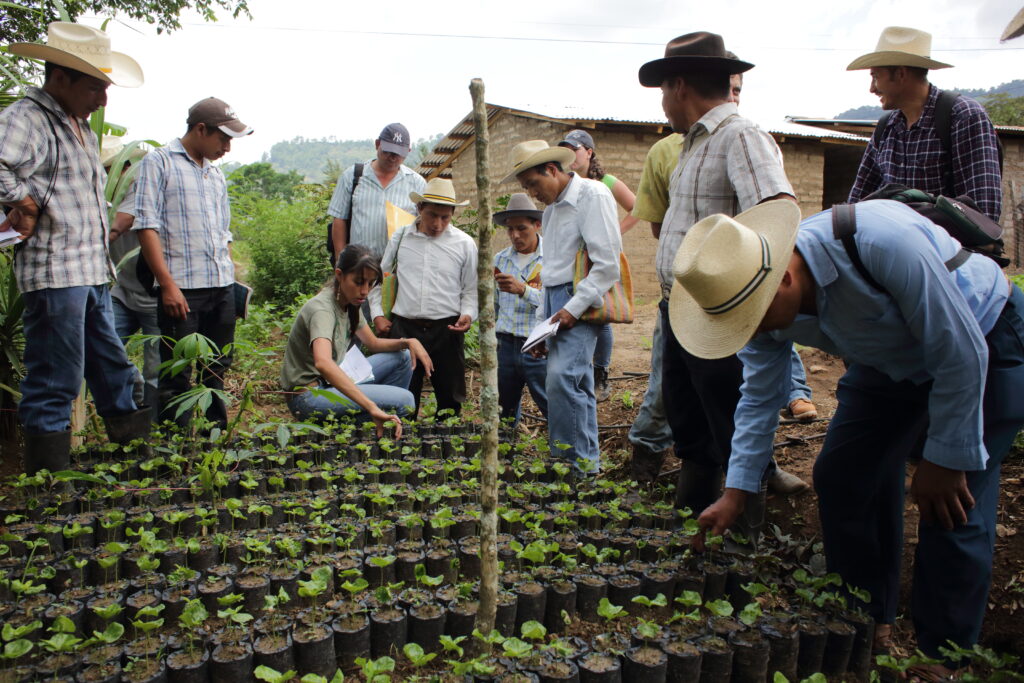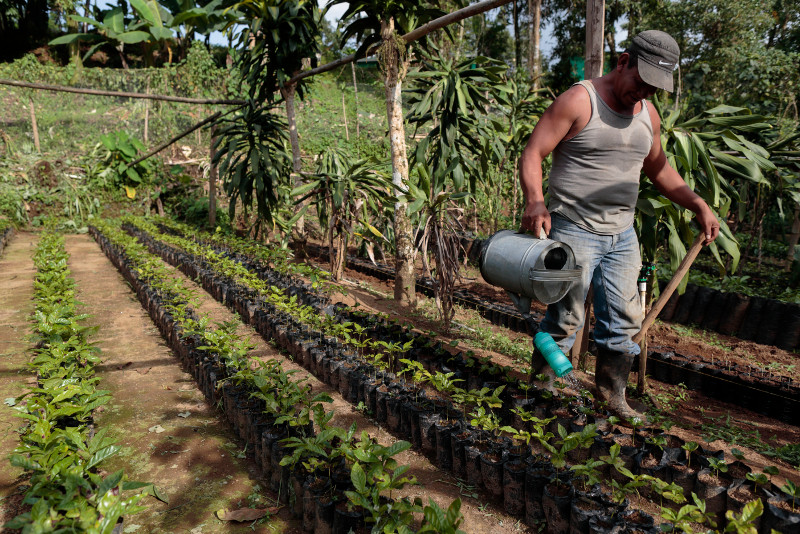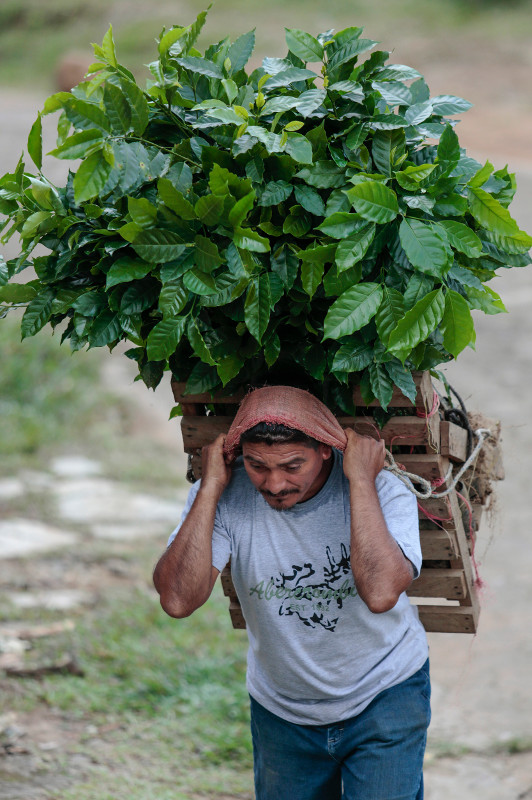A damaging fungus, coffee leaf rust (Hemileia vastatrix), swept across the coffeelands of Central America from 2012-2014. It left withered plants and battered livelihoods in its wake. Smallholder farmers, already living on the edge, lost 30—50% of their coffee production (read: their income) in a matter of months. Food insecurity stalked the region as a result, since farmers did not have the cash needed to buy the basics for their family, or to pay farm laborers. It took several years, and millions of dollars of investment, for coffee production to recover in the region. Warmer nights and cooler days were a common denominator during the latest outbreaks of rust in Central America and Colombia. A leading expert warned that these severe outbreaks of rust were “enhanced by weather conditions consistent with climate change.”[1]
Of course, farmers have no control over nighttime or daytime temperatures at a macrolevel, in much the same way agribusinesses or cooperatives can’t influence the frequency of extreme weather events, or whether this growing season will be one of abundant rains or one of drought. Nonetheless, farmers’ incomes, and agribusinesses’ outcomes, are intimately tied to the frequency and intensity of these climatic events. The outsized impact climate can have on agribusinesses’ and farmers’ bottom line was one of the unique challenges of investing in agriculture mentioned in the introductory post in this series (The Unique Challenges of Investing in Agriculture). This challenge has only been exacerbated in recent years by climate change.

Not surprisingly, given the devastation of the 2012-14 rust outbreak, many coffee coops in Central America were unable to honor their purchase contracts with their buyers during those years. I was working on coffee projects in Guatemala at that time, and I experienced firsthand the acute and prolonged impacts climate can have on farmers and agricultural businesses. Needless to say, if you had loaned money to a coffee coop during those years, they likely did not have the cashflow to pay you back until production recovered a few agricultural cycles later. There are few other industries and sectors where volatile and recurrent climate-driven impacts can take such a big bite out of revenue. But if you believe that investment in the agricultural sector is important for the planet, society, and the millions of families who live from the land -as we most certainly do- then these challenges must be understood, and then overcome. Investments in nature-based solutions are needed.
Impact finance can spur climate adaptation, and nature-based solutions
A major cost of running a productive and resilient coffee farm is renovation and rehabilitation. Coffee plants are most productive during their years 5 to 15. To maintain production and yields, it is essential to periodically rehabilitate and renovate the farm. As plants get older they are more susceptible to climate stressors. New coffee varieties brought to market over the past 10 years are often better suited to changing climate conditions in the region. In addition to improving production and building resilience, renovation can be an opportunity to modify the configuration of the farm, integrating additional tree species, expanding biodiversity. According to a study conducted by the Sustainable Coffee Challenge, a collaborative group of companies, NGOs, governments, and research institutions striving for a sustainable coffee industry, over 50% of total smallholder coffee lands in the world, about 3.5 million hectares, are in need of renovation & rehabilitation. If this renovation work was done, it could boost global coffee production by 5-20% without the need to expand onto 1.3 million additional hectares of land to maintain current production. These investments in renovation would also put $1-$3 billion of revenue into farmers’ pockets.[2]
However, despite the importance of renovation, due to the upfront outlay required to do the work, and the delayed return on investment (2-3 years once plants are producing again), most farmers are unable to make these investments in the land with their cash on hand. Many coffee cooperatives or traders would like to support their farmer providers to invest in farm renovation, and other climate resilient activities, but they struggle to find willing financial partners. There is a large financing gap for nature-based solutions/investments such as renovation & rehabilitation. Financial entities hone in on the major risk factors: the extended time period of the investments, the possibility of climate events derailing progress, and the administrative complexities of working with cooperatives or traders that aggregate hundreds, if not thousands, of farmers.
Nonetheless finance for green and nature-based solutions is growing and there is an opportunity for innovative, and impact-oriented, financial players to fill the gaps. CRS’ agricultural impact investment fund, Isidro [3], is developing a financial product for Nature-Based Solutions, with accompanying technical assistance, for our agribusiness clients. As we went through the design process, there were three critical features of financing for natural capital which seemed relevant to share.
- First, the timeline for these investments requires patience. In the case of renovation or other tree planting activities, a repayment period of 5-7 years gives the farmer adequate time to plant, withstand some up and down years, and ensure the new trees are established, producing, and generating a positive cashflow.
- Second, the structure of the investment must work for all parties. To reduce transaction costs for the lender, individual farmer loans should be handled directly by the cooperative or aggregator, leveraging the entity’s existing administrative infrastructure. For this arrangement to be attractive to the cooperative, they will have to on lend at a higher rate to cover their costs. Setting a price for midterm investments that is attractive to the lender, the borrower, and the farmer is complex but the upside for all three parties is clear. A royalty or revenue-based product, which allows for risk to be shared more evenly between the parties, is appropriate.
- Third, conducting a baseline on current agricultural practices, plant varieties, and potential climate impacts is critical. This initial information can act as the foundation for a robust technical assistance plan linked to the investment. After all, these plants will be in the ground for 10, 20 or more years. Finally, training on regenerative agriculture, including a package of soil and water management practices which can be implemented on-farm to boost yields and help mitigate climate concerns, helps ensure the investment is a success for the lender, the borrower, farmers, and the environment.
Nature-positive investments in farm renovation and rehabilitation have the potential to improve farmer productivity and income, diversify agroforestry systems and improve watershed management, limit agricultural expansion into primary forest, and strengthen rural businesses and cooperatives. The risk of these investments being pushed off track due to climatic events, such as a future outbreak of leaf rust, is a real possibility, but a blended finance product, which includes technical assistance, can mitigate many of these risks and set enterprises up to tackle one of the unique challenges that agribusinesses face.
[1] Avelino, J., Cristancho, M., Georgiou, S. et al. The coffee rust crises in Colombia and Central America (2008–2013): impacts, plausible causes and proposed solutions. Food Sec. 7, 303–321 (2015). https://doi.org/10.1007/s12571-015-0446-9
[2] Farm Renovation & Rehabilitation. Sustainable Coffee Challenge. https://www.sustaincoffee.org/farm-renovation-rehabilitation/
[3] www.isidrofund.org




